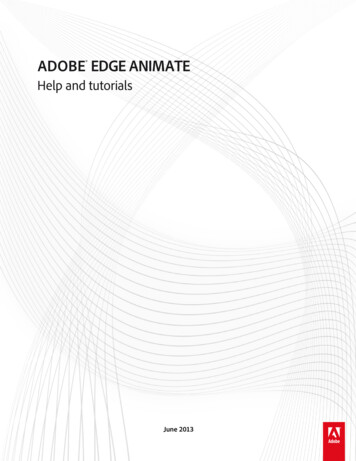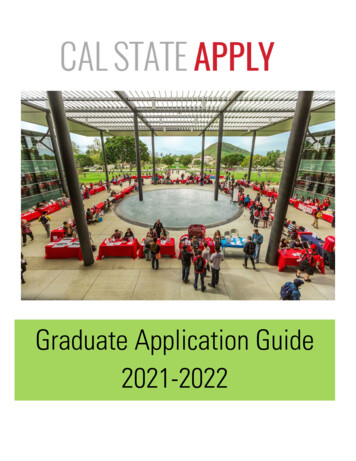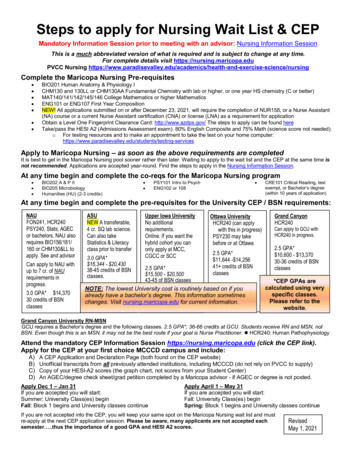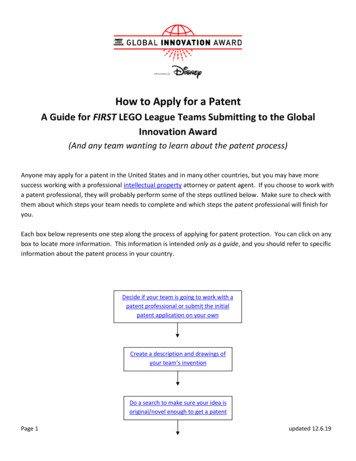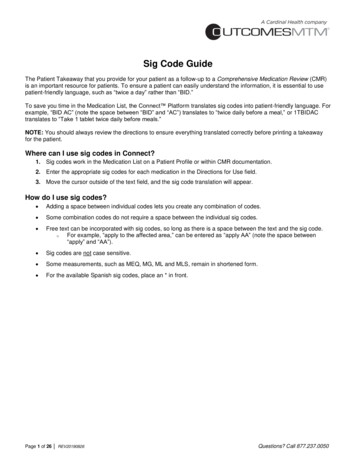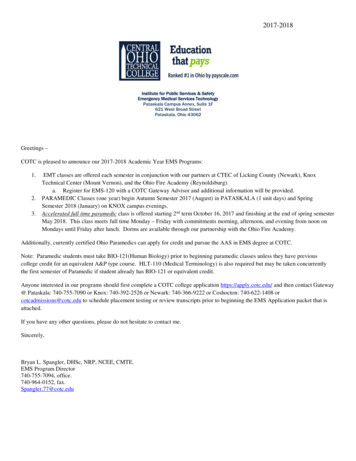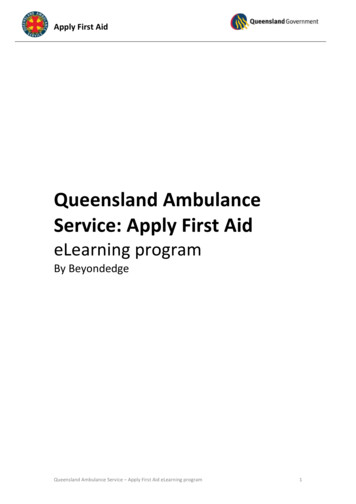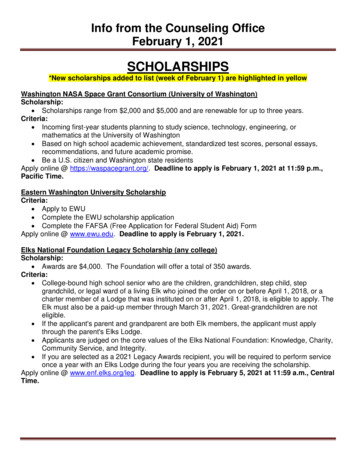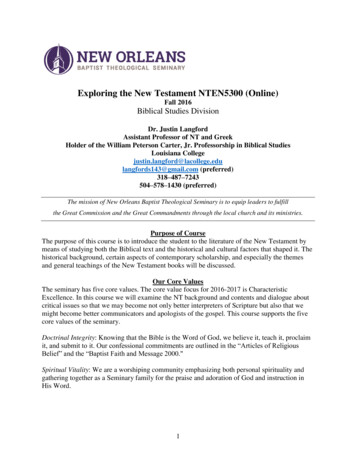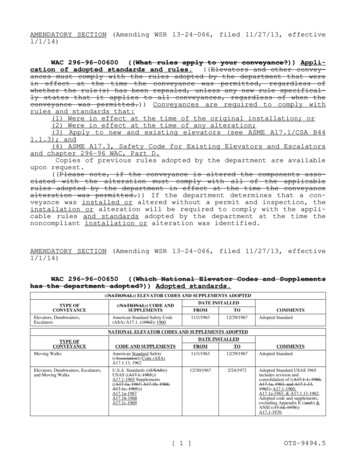
Transcription
AMENDATORY SECTION (Amending WSR 13-24-066, filed 11/27/13, effective1/1/14)WAC 296-96-00600 ((What rules apply to your conveyance?)) Appli cation of adopted standards and rules. ((Elevators and other convey ances must comply with the rules adopted by the department that werein effect at the time the conveyance was permitted, regardless ofwhether the rule(s) has been repealed, unless any new rule specifical ly states that it applies to all conveyances, regardless of when theconveyance was permitted.)) Conveyances are required to comply withrules and standards that:(1) Were in effect at the time of the original installation; or(2) Were in effect at the time of any alteration;(3) Apply to new and existing elevators (see ASME A17.1/CSA B441.1.3); and(4) ASME A17.3, Safety Code for Existing Elevators and Escalatorsand chapter 296-96 WAC, Part D.Copies of previous rules adopted by the department are availableupon request.((Please note, if the conveyance is altered the components asso ciated with the alteration must comply with all of the applicablerules adopted by the department in effect at the time the conveyancealteration was permitted.)) If the department determines that a con veyance was installed or altered without a permit and inspection, theinstallation or alteration will be required to comply with the appli cable rules and standards adopted by the department at the time thenoncompliant installation or alteration was identified.AMENDATORY SECTION (Amending WSR 13-24-066, filed 11/27/13, effective1/1/14)WAC 296-96-00650 ((Which National Elevator Codes and Supplementshas the department adopted?)) Adopted standards.((NATIONAL)) ELEVATOR CODES AND SUPPLEMENTS ADOPTEDTYPE OFCONVEYANCEElevators, Dumbwaiters,EscalatorsDATE INSTALLED((NATIONAL)) CODE ANDSUPPLEMENTSAmerican Standard Safety Code(ASA) A17.1, ((1962)) 1960FROMTO11/1/196312/29/1967COMMENTSAdopted StandardNATIONAL ELEVATOR CODES AND SUPPLEMENTS ADOPTEDTYPE OFCONVEYANCEDATE INSTALLEDCODE AND SUPPLEMENTSFROMTOCOMMENTSMoving WalksAmerican Standard Safety((Association)) Code (ASA)A17.1.13, 196211/1/196312/29/1967Adopted StandardElevators, Dumbwaiters, Escalators,and Moving WalksU.S.A. Standards (((USAS)))USAS ((A17.1, 1965;))A17.1-1965 Supplements((A17.1a, 1967; A17.1b, 1968;A17.1c, 2/24/1972Adopted Standard USAS 1965includes revision andconsolidation of ((A17.1-1, 1960,A17.1a, 1963, and A17.1-13,1962)) A17.1-1960,A17.1a-1963, & A17.1.13-1962.Adopted code and supplements,excluding Appendix E ((and)) &ANSI ((17.1d, 1970))A17.1-1970.[ 1 ]OTS-9494.5
NATIONAL ELEVATOR CODES AND SUPPLEMENTS ADOPTEDTYPE OFCONVEYANCEDATE INSTALLEDCODE AND SUPPLEMENTSFROMTOCOMMENTSElevators, Dumbwaiters, Escalators,and Moving WalksAmerican National StandardsInstitute ((ANSI A17.1, 1971))A17.1-19712/25/19726/30/1982Adopted Standard as amendedand revised through 1971.Elevators, Dumbwaiters, Escalators,and Moving WalksANSI((A17.1, 1971; A17.1a, 1972))A17.1-1971; A17.1a-19722/25/19726/30/1982Adopted SupplementElevators, Dumbwaiters, Escalators,and Moving WalksANSI((A17.1, 1981))A17.1-19817/1/19821/9/1986Adopted StandardElevators, Dumbwaiters, Escalators,and Moving WalksANSI((A17.1a, 1982))A17.1a-19823/1/19841/9/1986Adopted SupplementElevators, Dumbwaiters, Escalators,and Moving WalksANSI((A17.1b, 1983))A17.1b-198312/1/19841/9/1986Adopted Supplement, exceptportable escalators covered byPart VIII ((of A17.1b, 1983))A17.1b-1983.Elevators, Dumbwaiters, Escalators,and Moving WalksANSI((A17.1, 1984))A17.1-19841/10/198612/31/1988Adopted Standard Except PartXIX. After 11/1/1988 Part II,Rule 211.3b was replaced byWAC 296-81-275.Elevators, Dumbwaiters, Escalators,and Moving WalksANSI((A17.1a, 1985))A17.1a-19851/10/198612/31/1988Adopted SupplementElevators, Dumbwaiters, Escalators,and Moving WalksANSI ((A17.1b, 1985; A17.1c,1986; A17.1d, 1986; and A17.1e,1987)) 98712/31/1988Adopted SupplementElevators, Dumbwaiters, Escalators,and Moving WalksANSI((A17.1, 1987))A17.1-19871/1/198912/31/1992Adopted Standard Except PartXIX and Part II, Rule 211.3b.WAC 296-81-275 replaced PartII, Rule 211.3b.Elevators, Dumbwaiters, Escalators,and Moving WalksASME((A17.1, 1990))A17.1-19901/1/19932/28/1995Adopted Standard Except PartXIX and Part V, Section 513.Chapter 296-94 WAC replacedPart V, Section 513.Elevators, Dumbwaiters, Escalators,and Moving WalksASME((A17.1, 1993))A17.1-19933/1/19956/30/1998Adopted Standard Except PartXIX and Part V, Section 513.Chapter 296-94 WAC replacedPart V, Section 513.Elevators, Dumbwaiters, Escalators,and Moving WalksASME((A17.1, 1996))A17.1-19966/30/19986/30/2004Adopted Standard Except Part V,Section 513.Elevators, Dumbwaiters, Escalators,and Moving WalksASME ((A17.1, 2000; A17.1a,2002; A17.1b, 2003)) opted Standards and AddendaExcept Rules 2.4.12.2, 8.6.5.8and Sections 5.4, 7.4, 7.5, 7.6,7.9, 7.10, 8.10.1.1.3 and 8.11.1.1.Safety Standards for Platform Liftsand Stairway ChairliftsASME ((A18.1, 1999; A18.1a,2001; A18.1b, 2001)) opted Standards and Addenda.Safety Code for Elevators, Escalators,Dumbwaiters, Residential Elevators,Special PurposeASME A17.1-2004((;))A17.1a-20051/1/20081/1/2014Adopted Standards and AddendaExcept Rules 2.4.7.2, marked cartop clearance space, 8.6.5.8,Maintenance of safety bulkhead,5.4, Private residence inclineelevators, 7.4 & 7.5 &7.9 & 7.10Material lifts, 8.10.1.1.3 and8.11.1.1, QEI-1 inspector.Safety Code for Platform Lifts andStairway ChairliftsASME A18.1-20051/1/20081/1/2014Safety Code for Belt ManliftsASME A90.1-20031/1/20081/1/2014Safety Code for Personnel Hoists,RetroactiveANSI A10.4-20041/1/20081/1/2014Safety Code for Elevators, Escalators,Dumbwaiters, Residential Elevators,Special PurposeASME A17.1-20101/1/2014((Current))8/31/2018[ 2 ]OTS-9494.5
NATIONAL ELEVATOR CODES AND SUPPLEMENTS ADOPTEDTYPE OFCONVEYANCEDATE INSTALLEDCODE AND SUPPLEMENTSFROMTOStandard for Elevator Suspension,Compensation, and GovernorSystemsASME A17.6-20101/1/2014CurrentSafety Code for Platform Lifts andStairway ChairliftsASME A18.1-20111/1/2014((Current))8/31/2018Safety Code for Belt Manlifts((Safety))ASME A90.1-20091/1/2014((Current))8/31/2018Safety Code for Personnel HoistsANSI A10.4-20071/1/2014((Current))8/31/2018Safety Code for Elevators, Escalators,Dumbwaiters, Residential Elevators,and Special PurposeASME A17.1-2016/CSAB44-169/1/2018CurrentGuide for Inspection of Elevators,Escalators, and Moving WalksASME A17.2-20179/1/2018CurrentSafety Code for Existing Elevatorsand EscalatorsASME A17.3-20159/1/2018CurrentSafety Standards for Platform Liftsand Stairway Chair LiftsASME A18.1-20179/1/2018CurrentSafety Code for Belt ManliftsASME A90.1-20159/1/2018CurrentSafety Code for Personnel HoistsASSE/ANSIA10.4-20169/1/2018CurrentSafety Code for Material NTSCopies of codes and supplements can be obtained from the following: The American Society of Mechanical Engineers (ASME), OrderDepartment((, 22 Law Drive, Box 2900, Fairfield)) 150 Clove Road, 6th Floor, Little Falls, New Jersey((, 07007-2900)) 07424-2138 or byvisiting www.asme.org. The American Society of Safety Engineers (ASSE) 1800 East Oakton Street, Des Plaines, IL 60018-2187 or byvisiting www.asse.org.Comments: ((National)) Codes adopted by this chapter will beidentified with the applicable ASME/ANSI code reference number con tained within the rules or as excluded or amended ((below)) in WAC296-96-00675.(((1) Exclude all references to QEI certification in ASME A17.1from code adoption.(2) Exclude all references and sections to Aramid fiber ropes inASME A17.1 and A17.6 from code adoption.(3) ASME A17.1, SECTION 1.2 PURPOSE AND EXCEPTIONS amended as follows:The purpose of this code is to provide for the safety of life andlimb, and to promote the public welfare. Compliance with this codeshall be achieved by:(a) Conformance with the requirements in ASME A17.1/CSA B44 andchapter 296-96 WAC. Additions or modifications to ASME A17.1/CSA B44and/or chapter 296-96 WAC shall require approval from the department;or(b) Conformance with a combination of the requirements in ASMEA17.1/CSA B44, chapter 296-96 WAC, and ASME A17.7/CSA B44.7 with thefollowing ASME A17.7 inclusions:(i) All system or component certifications performed by an ac credited elevator/escalator certification organization (AECO) underASME A17.7/CSA B44.7, shall be approved by the department before anysuch system or component is allowed to be permitted or installed inthe state of Washington. The applicant must submit all code documenta tion required by ASME A17.7 Section 2.10 and any other documentationas may be requested.(ii) Sections of chapter 296-96 WAC that have taken exception to,made additions to, or modifications to ASME A17.1/CSA B44, such excep tions, additions and modifications shall supersede corresponding re quirements in ASME A17.7/CSA B44.7.[ 3 ]OTS-9494.5
(iii) The department has the final authority regarding acceptanceof any item in ASME A17.7. The department may remove approval if a de sign has changed or unforeseen or undisclosed information is obtained.(iv) The department will post the specific ASME A17.7 AECO cer tificate including exceptions agreed upon. At that time the certifi cate and exceptions become part of the adopted rule in the state ofWashington and not subject to a variance process. The installer shallpost the certificate and exceptions including all required informationon each conveyance installed utilizing the ASME A17.7 method.(v) The department may charge an additional fee for each item inreview based upon the variance fee table.(4) MARINE ELEVATOR SECTION 5.8This chapter only applies to elevators installed on board a ma rine vessel flying the Washington state flag and under one hundredgross metric tons.(5) Exclude ASME A17.1-2.4.7.2 reference for clearance reduction.(6) Exclude ASME A17.1-5.4 private residence incline elevatorsand ASME A17.1-7.4, 7.5, 7.6, 7.9, and 7.10 material lifts and theircorresponding 8.10.1.1.3.(7) Exclude ASME A17.1-2.14.1.5.2 on elevators in partially en closed hoistways. A top emergency exit shall be required.))NEW SECTIONWAC 296-96-00675Amendments to adopted standards.(1) Excludeall references to QEI certification in ASME A17.1/CSA B44 from codeadoption.(2) ASME A17.1/CSA B44, Section 1.2 Purpose and Exceptions amen ded as follows: The purpose of this code is to provide for the safetyof life and limb, and to promote the public welfare. Compliance withthese rules shall be achieved by:(a) Conformance with the requirements in ASME A17.1/CSA B44 asamended by this chapter; or(b) Conformance with a combination of requirements in ASMEA17.1/CSA B44, this chapter, and ASME A17.7/CSA B44.7 with the follow ing ASME A17.7/CSA B44.7 inclusions:(i) All system or component certifications performed by an Ac credited Elevator/Escalator Certification Organization (AECO) underASME A17.7/CSA B44.7 shall be approved by the department before anysuch system or component is allowed to be permitted or installed inthe state of Washington.(ii) The applicant shall provide the certificate of certificationfor the device or system evaluated by an AECO.(iii) The department has the final authority regarding acceptanceof any item in ASME A17.7/CSA B44.7. The department may remove appro val if a design has changed or unforeseen or undisclosed informationis obtained.(iv) The department will post the specific ASME A17.7/CSA B44.7AECO certificate including exceptions agreed upon. At that time thecertificate and exceptions become part of the adopted rule in thestate of Washington and not subject to a variance process. The instal ler shall include the certificate and exceptions and all required in formation on each conveyance installed utilizing the ASME A17.7/CSAB44.7 method in the Maintenance Control Program documentation.[ 4 ]OTS-9494.5
(v) The department may charge an additional fee for each item inreview based upon the variance fee table.(c) Additions or modifications to adopted standards and/or thischapter shall require approval from the department.(3) ASME A17.1/CSA B44, Section 5.8, Marine Elevators. This sec tion only applies to elevators installed on board a marine vessel fly ing the Washington state flag and under one hundred gross metric tons.(4) ASME A17.1/CSA B44, Section 5.11, Wind Turbine Elevator isnot adopted.(5) Periodic tests and inspections. Pursuant to Req. 8.6.1.7 and8.11.1.3, the department adopts ASME A17.1/CSA B44, Appendix N for thefrequency of periodic tests. Pursuant to RCW 70.87.120 (2)(a) periodicinspections shall be performed annually.(6) ASME A17.1/CSA B44 requirement 8.11.1.1.2 is not adopted. Thedepartment shall be permitted to witness periodic tests when the de partment deems necessary.(7) ASME A17.1-2016/CSA B44-16, 8.6.11.1 Firefighters' EmergencyOperation is amended as follows: All elevators provided with fire fighters' emergency operation shall be subjected quarterly, by author ized personnel, to Phase I recall by use of the keyed switch, and aminimum of one-floor operation on Phase II. Deficiencies shall be cor rected. A record of findings shall be available to elevator personneland the authority having jurisdiction. At least once each year, thefire alarm initiating devices associated with elevator recall andshunt trip initiating devices shall be tested to determine if they arestill properly interfaced with the elevator control.AMENDATORY SECTION (Amending WSR 13-24-066, filed 11/27/13, effective1/1/14)WAC 296-96-00700 Chapter definitions. The following definitionsapply to this chapter (see RCW 70.87.010 and ASME A17.1/CSA B44 foradditional definitions necessary for use with this chapter):"ANSI" means the American National Standard Institute."ASA" means the American Safety Association."ASME" means the American Society of Mechanical Engineers."Acceptable proof" refers to the documentation that ((must)) isrequired to be provided to the department during the elevator contrac tor and mechanic license application and renewal process. ((Acceptableproof may include department-approved forms documenting years of expe rience, affidavits, letters from previous employers, declarations ofexperience, education credits, copies of contractor registration in formation, etc. Additional documentation may be requested by the de partment to verify the information provided on the application.))"Alteration" means an intended change to the original design ofelevator equipment."Code" refers to nationally ((accepted)) recognized codes (i.e.,ASME, ANSI, ((ASA, and NEC)) ICC, and NFPA) and the Washington Admin istrative Code.(("Control room" refers to an enclosed control space outside thehoistway of the elevator or dumbwaiter, intended for full bodily entrythat contains the motor and motion controller. The room could alsocontain electrical and/or mechanical equipment used directly in con [ 5 ]OTS-9494.5
nection with the elevator or dumbwaiter, but not the electric drivingmachine."Control space" refers to a space outside the hoistway of the el evator, intended to be accessed without full bodily entry, which con tains the motor and motion controller. This space could also containelectrical and/or mechanical equipment used directly in connectionwith the elevator but not the electric driving machine or the hydraul ic machine. A control space* is limited to elevators, dumbwaiters,special purpose, and material lifts. The space shall not share any lo cation, area or room which is also accessible to the general public.*Note:A control space must be preapproved and is limited on a case-by-case basis and should not be considered a normal installation process.))"Decommissioning conveyance" means a group of tasks that ((must))are to be accomplished in order to place the conveyance in a long-termout-of-service status.(("Elevator machine room" means an enclosed machinery room out side the hoistway, intended for full bodily entry that contains theelectric driving machine or the hydraulic machine and the motor con troller. The room could also contain electrical and/or mechanicalequipment used directly in connection with the elevator."Elevator machinery space" means a space inside or outside thehoistway, intended to be accessed with or without full bodily entrythat contains elevator mechanical equipment and could also containelectrical equipment used directly in connection with the elevator.This space could also contain the electric driving machine.))"Examination" means a routine process or procedural task(s) ortest(s) that ensures a conveyance and its systems and subsystems re main properly maintained and safe to operate."Final judgment" means any money that is owed the department asthe result of an individual's or firm's unsuccessful appeal ((of)) orfailure to appeal a civil penalty. ((Final judgment also includes anypenalties assessed against an individual or firm owed the departmentas a result of an unappealed civil penalty or any outstanding fees dueunder chapter 70.87 RCW and this chapter.))"Form, fit, and function" means specific characteristics of a de vice (such as a component or assembly) that enable direct substitutionof the device for a similar device without adversely affecting the op eration or safety of the overall equipment. Factors to be consideredwith respect to form, fit, and function include, but are not alwayslimited to: The ability of the device to be connected in place of theoriginal; having similar size, shape and appearance; ability to per form the same function as the original device; and having ratingsequal to or greater than the original device."General direction - Installation and alteration work" means thenecessary education, assistance, and supervision provided by a li censed elevator mechanic (in the appropriate license category) who ison the same job site as the helper/apprentice ((at least seventy-fivepercent of each working day. The ratio of helper to mechanic shall beone-to-one))."General direction - Maintenance work" means the necessary educa tion, assistance, and supervision provided by a licensed elevator me chanic (in the appropriate license category) to ensure that the main tenance work is performed safely and to code."Layout drawings" or "plans" or "shop drawings" means ((engineer ing)) elevation and plan view drawings that show required clearancesand dimensions of elevator equipment in relation to building structureand ((shall include a machine room plan, hoistway plan, hoistway ele [ 6 ]OTS-9494.5
vation, detail drawings, and general elevator data)) other elevatorequipment."Layout drawings, engineering" means structural drawings verifiedand stamped by a professional engineer registered in the state ofWashington."Lockout/tagout" means the placement of a lockout device on anenergy isolating device((, in accordance with an established proce dure, ensuring that the energy isolating device and the equipment be ing controlled cannot be operated until the lockout device is re moved))."Primary point of contact" is the designated individual employedby a licensed elevator contractor."Private residence elevator" (((residential elevator))) means apower passenger elevator which ((is limited in size, capacity, riseand speed and)) is installed in a private residence or multiple dwell ing as a means of access to a single private residence ((provided theelevators are so installed that they are not accessible to the generalpublic or to other occupants in the building))."Red tag" or "red tag status" means an elevator or other convey ance that has been removed from service and operation because of non compliance with chapter 70.87 RCW and this chapter or at the requestof the owner."Repair" means a procedure used to restore a device or system toits original design parameters without supplying a complete new compo nent or device."Replacement" means the complete replacement of a device or com ponent that has the same "form, fit, and function" as the original butis not intended as a change in design."RCW" means the Revised Code of Washington.(("Tagout" means the placement of a tagout device on an energyisolating device, in accordance with an established procedure, to in dicate that the energy isolating device and the equipment being con trolled may not be operated until the tagout device is removed by theindividual who established the tag or by a person designated by thechief elevator inspector.)) "Standard application material lift" meansa lift used strictly for freight transport and is in compliance withthis chapter, Part C1. (Note: These are not to be confused with Type Aand Type B material lifts covered in ASME A17.1/CSA B44, Part 7)."Traction elevator" means an elevator in which the friction be tween the hoist ropes and the drive machine sheave is used to move theelevator car."USAS" means the U.S.A. Standards."WAC" means the Washington Administrative Code.AMENDATORY SECTION (Amending WSR 04-12-047, filed 5/28/04, effective6/30/04)WAC 296-96-00800Advisory committee on conveyances.(1) Thepurpose of the advisory committee is to advise the department on theadoption of regulations that apply to conveyances; methods of enforc ing and administering the elevator law, chapter 70.87 RCW; and mattersof concern to the conveyance industry and to the individual instal lers, owners and users of conveyances.[ 7 ]OTS-9494.5
(2) The advisory committee consists of seven members appointed bythe director or his or her authorized representative.(3) The committee members shall serve four years. However, if amember is unable to fulfill his or her obligations, a new member maybe appointed to fill the remainder of the unexpired term.(4) The committee shall meet on the third Tuesday of February,May, August, and November of each year, and at other times at the dis cretion of the chief of the elevator section.(5) The chief of the elevator section shall be the secretary forthe advisory committee.(6) An advisory committee member may appoint an alternate to at tend meetings in case of conflict or illness.AMENDATORY SECTION (Amending WSR 04-12-047, filed 5/28/04, effective6/30/04)WAC 296-96-00805 Appeal rights and hearings. (1) Chapter 70.87RCW provides the authority for the duties and responsibilities of thedepartment. Except as provided in chapter 70.87 RCW and this chapter,all appeals and hearings will be conducted according to chapter 34.05RCW, the Administrative Procedure Act and chapter 10-08 WAC, ModelRules of Procedure.(2) A person who contests a notice of violation or infraction is sued by the department may request a hearing. The request for a hear ing ((must)) shall be:(a) In writing;(b) Accompanied by a certified or cashier's check, payable to thedepartment, for ((two hundred dollars)) the amount specified in theRCW; and(c) Postmarked or received by the department within ((fifteen))15 days after the person receives the department's violation notice.(3) In all appeals of chapter 70.87 RCW and this chapter the ap pellant has the burden of proof by a preponderance of the evidence.AMENDATORY SECTION (Amending WSR 13-24-066, filed 11/27/13, effective1/1/14)WAC 296-96-01000 ((What is the permit process for conveyances?))Permits for new construction and alterations. (1) Prior to construc tion, alteration, or relocation of any conveyance, the licensed eleva tor contractor shall:(a) Submit an installation application to the department. See WAC296-96-01010 through 296-96-01025.(b) Submit plans to the department for approval. See WAC296-96-01030.EXCEPTION:Most alterations will not require plans.(c) Post an approved installation or alteration permit along withany approved plans issued by the department on the job site.(i) The annual operating certificate is considered suspended oncealteration work begins.[ 8 ]OTS-9494.5
(ii) The certificate shall not be reinstated until the alterationwork is approved by an inspector employed by the department.(((d))) (2) Prior to placing a conveyance in service the licensedelevator contractor shall obtain and pass an inspection ((prior toplacing the conveyance in service. See WAC 296-96-01035.(e) Abstain from working without a permit or releasing the con veyance for use without the department's written permission)) or re ceive written permission from the department.(3) Failure to comply with subsections (1) and (2) of this sec tion is a violation of this chapter and may result in civil penalties(WAC 296-96-01070 (1)(a) through (d)).(((2))) (4) The owner ((must)) shall obtain and renew an annualoperating certificate for each conveyance that they own, except forresidential conveyances. See WAC 296-96-01065.(((3))) (5) After initial purchase and inspection, private resi dence conveyance(s) do not require an annual operating certificate.However, annual inspections may be conducted upon request. See WAC296-96-01045 for the permit process.(6) For purposes of this rule, permits are not required for "re pairs" (see ASME A17.1/CSA B44, Section 8.6.2). Permits are not re quired when replacing devices that are identical to the original de vice or have the same "form, fit, and function" (see WAC 296-96-00700)(see also ASME A17.1/CSA B44, Section 8.6.3).AMENDATORY SECTION (Amending WSR 14-06-041, filed 2/26/14, effective4/1/14)WAC 296-96-01005 ((When do I need and what are the steps in ob taining a permit?)) Obtaining permits.(1) See WAC 296-96-01000 forthe permit process.(2) Construction and alteration permits are valid for one yearfrom the date of issue. However, permits may be renewed if ((you)):(a) ((Apply)) Application for a renewal permit is submitted be fore ((your)) the current permit expires;(b) The department approves ((your)) the request for a renewalpermit; and(c) ((You pay)) A renewal fee of 58.30 ((renewal fee)) is paidto the department for each permit ((you renew)) renewed;(3) If ((your)) the permit has expired ((you must)) the applicantshall reapply for a new permit.(4) See WAC 296-96-01006 for work requiring a permit.AMENDATORY SECTION (Amending WSR 07-24-041, filed 11/30/07, effective1/1/08)WAC 296-96-01006 ((What type of conveyance work requires permit ting and inspection?)) Work requiring permits. (1) All installationsand relocation of conveyances that require((s)) permitting and inspec tion((. All conveyance work must)) shall be performed by ((an)) eleva tor mechanics licensed to perform work in the appropriate category.(See WAC 296-96-00910.)[ 9 ]OTS-9494.5
(2) ((All alterations require permitting, inspection, and mustinclude but are not limited to:(a))) Items identified in ASME ((A17.1.(b) Any conveyance work that requires the conveyance to be testedprior to being returned to service, including:(i) The replacement or repair of any parts, the installation ofwhich would require recalibration or testing (e.g., brakes, hydraulicvalves and piping, safeties, door reopening devices, governors, commu nication systems, cab interiors, car/hall buttons, etc.); or(ii) Work performed on components or equipment affecting or nec essary for fire and life safety (e.g., cab interiors, systems associ ated with fire recall, etc.))) A17.1/CSA B44, Section 8.7 as altera tions shall require a permit and inspection.(3) Permits and fees are not required for normal function andnecessary maintenance ((and)) or repair ((performed with parts ofequivalent materials, strength, and design)) or for any conveyance((exempted by)) exempt under RCW 70.87.200.Contact the department if you have any questions or need assis tance determining if a permit and inspection are required.AMENDATORY SECTION (Amending WSR 13-24-066, filed 11/27/13, effective1/1/14)WAC 296-96-01008 Decommissioning a conveyance. A licensed ele vator mechanic working for a licensed elevator company ((must)) shalldecommission the conveyance according to ASME A17.1/CSA B44. If theelevator is the only one in the building and the owner/agent wants theconveyance decommissioned the owner/agent ((must)) shall obtain a let ter of approval from the local building official.Note:Decommissioning is not ((dismantling or)) removing the conveyance.(1) ((A conveyance is considered to be in decommissioned statuswhen:(a) The power feed lines from the disconnect switch to the con troller have been removed; and(b) The traction elevator, dumbwaiter, or material lift suspen sion ropes have been removed, and if applicable, the counterweightrests at the bottom of the hoistway. The hoistway doors, except forthe bottom landing, have been permanently barricaded or sealed in theclosed position on the hoistway side; and(c) A hydraulic elevator, dumbwaiter, or material lift car restsat the bottom of the hoistway; pressure piping has been disassembledand a section removed from the premises; hoistway doors except for thebottom landing have been permanently barricaded or sealed in theclosed position on the hoistway side; suspension ropes have been re moved and counterweights, if provided, landed at the bottom of thehoistway; and(d) The escalator or moving walk entrances have been permanentlybarricaded.(2))) After decommissioning work is complete:(a) The elevator mechanic ((must)) shall contact the departmentto schedule an inspection;(b) The department will perform an inspection and send the re sults and applicable fee to the conveyance owner;[ 10 ]OTS-9494.5
(c) Upon inspection and approval by the department, annual in spections will no longer be required, until such time that the convey ance is returned to service.(((3) If returning the conveyance to service and prior to operat ing the conveyance,)) (2) Prior to returning a decommissioned convey ance to service an acceptance inspection and temporary operating per mit ((must)) shall be obtained. The conveyance acceptance inspectionshall be performed to the code in effect from the date of its originalinstallation ((or)) and/or alteration.AMENDATORY SECTION (Amending WSR 07-24-041,
XIX and Part V, Section 513. Chapter 296-94 WAC replaced Part V, Section 513. Elevators, Dumbwaiters, Escalators, and Moving Walks ASME ((A17.1, 1993)) . ASME A17.1, SECTION 1.2 PURPOSE AND EXCEPTIONS amended as follows: The purpose of this code is to provide for the safety of life and limb, and to promote the public welfare. .
